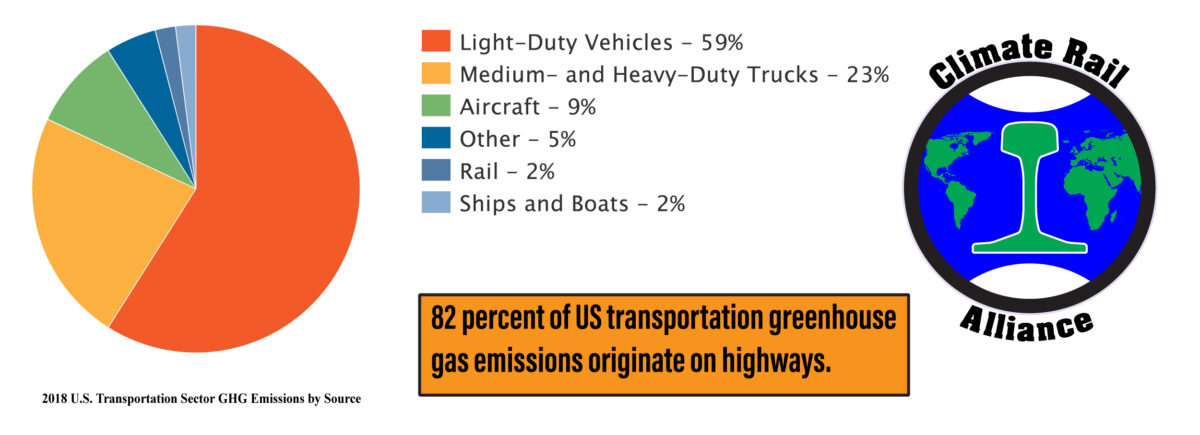Today, 1/21/21, as the WA House Transportation Committee holds hearings on the proposed budget and supplemental budget bills (1135 and 1136), we are submitting testimonies and emails requesting funding to update the Amtrak Cascades Long Range Plan (LRP) and begin environmental engineering work. Such an update and preliminary work would make the program ‘shovel-ready’ for re-starting this important infrastructure project. (Of course that would also require significant federal funding.) The LRP was initiated in 1993 at the direction of RCW 49.79.020, was further updated in 2006, and then promptly forgotten.
Why is this important? As our name suggests, rail effectively addresses the current and impending global reality of climate catastrophe by reducing CO2 emissions by 2/3 from the transportation sector. The directive from the Legislature nearly 30 years ago to expand our Amtrak passenger rail system is in fact even more pertinent today in the struggle for aggressive action on climate, as well as for addressing mobility justice, environmental justice, and economic recovery post COVID-19 pandemic.
RCW 47.79.020 “Program established—Goals”.
“The legislature finds that there is substantial public benefit to establishing a high-speed ground transportation program in this state. The program shall implement the recommendations of the high-speed ground transportation steering committee report dated October 15, 1992. The program shall be administered by the department of transportation in close cooperation with the utilities and transportation commission and affected cities and counties.The high-speed ground transportation program shall have the following goals:(1) Implement high-speed ground transportation service offering top speeds over 150 m.p.h. between Everett and Portland, Oregon by 2020. This would be accomplished by meeting the intermediate objectives of a maximum travel time between downtown Portland and downtown Seattle of two hours and thirty minutes by the year 2000 and maximum travel time of two hours by the year 2010;(2) Implement high-speed ground transportation service offering top speeds over 150 m.p.h. between Everett and Vancouver, B.C. by 2025;(3) Implement high-speed ground transportation service offering top speeds over 150 m.p.h. between Seattle and Spokane by 2030. The department of transportation shall, subject to legislative appropriation, implement such projects as necessary to achieve these goals in accordance with the implementation plans identified in RCW 47.79.030 and 47.79.040.”
In the first volume of the LRP, the goals of the RCW are clearly stated. Executive Summary, page vii, states:
“”In October 1992, the High Speed Ground Transportation Study was delivered to the Governor and the legislature. This study confirmed the feasibility of developing high speed rail in the region. Following release of this study in April 1993, WSDOT was directed (Revised Code of Washington Chapter 47.79) to develop “high-quality intercity passenger rail service … through incremental upgrading of the existing [Amtrak] service.” The legislature believed that this step-by-step approach would help to build a “rail culture” in the region that would eventually make rail a competitive and viable alternative to automobile and regional air travel.””
As a lay person interested in climate activism, I am seeking to put an urgent perspective on our endeavor to fund and implement the Amtrak Cascades Long Range Plan, a blueprint that was carefully and thoroughly drafted three decades ago as directed by RCW 47.79.020. Our intention is that our Governor and Legislature and Department of Transportation will see the economic, environmental and social benefits of using our current infrastructure and established law to build out an efficient rail system. Ours is not a radical endeavor. It will not cost jobs. It will create jobs. It does not run counter to any laws. It enacts current law. It presents a pragmatic and feasible example of a jobs and infrastructure mobilization. Our fight historically has been with the culture of denial of the benefit of rail, the history of under-utilizing rail precisely because it is far less energy intensive (requiring 2/3 less energy). Why would the energy companies invest in a mode that uses 2/3 less energy? Of course we know why. That is the elephant in the room. At this opportune and critical moment we need to shed light on the vital importance of rail. Many dedicated individuals and groups have led the charge in this fight, and we have a long way still to go.
LW
